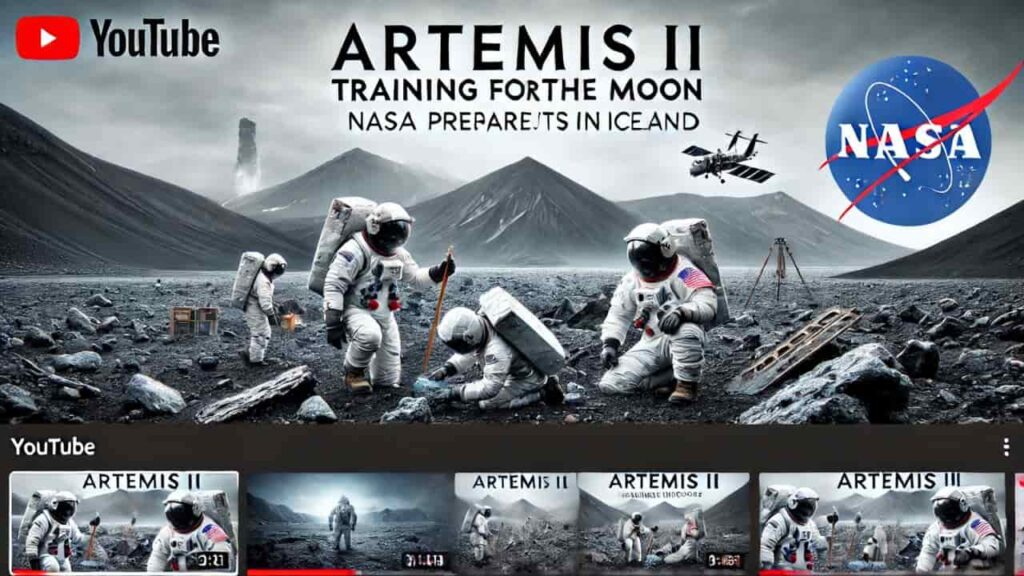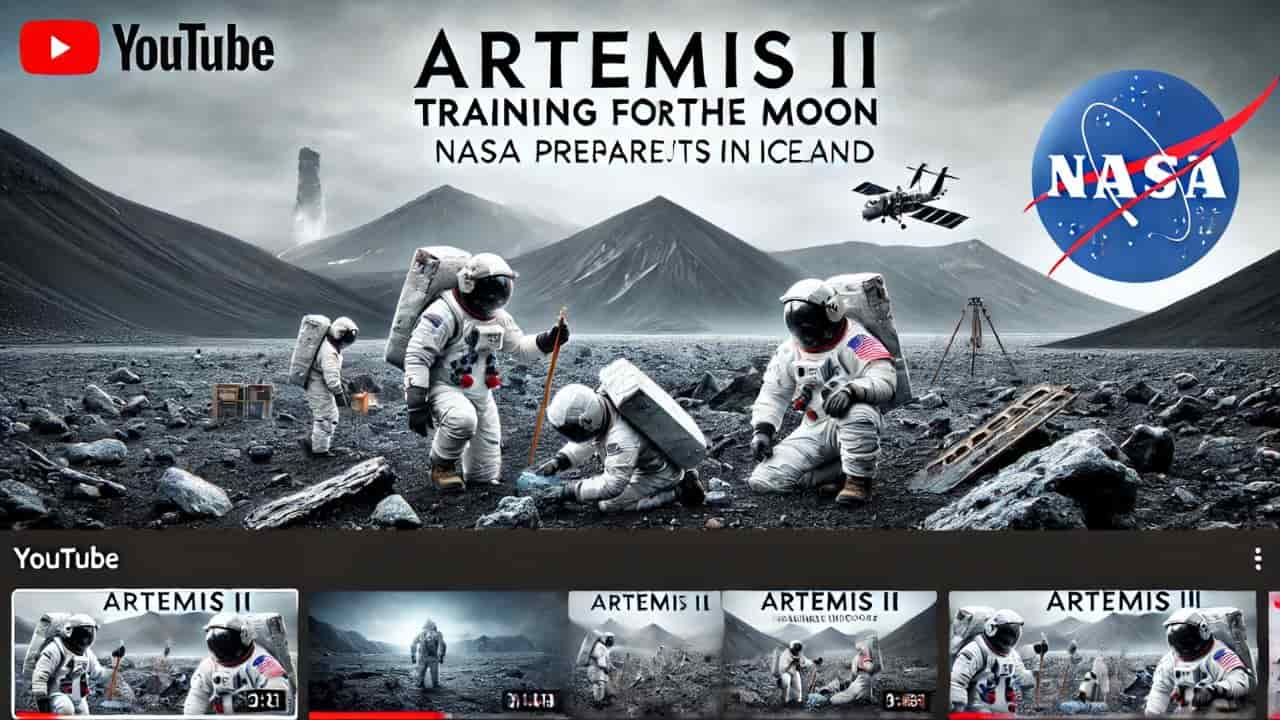NASA Artemis II, Artemis mission, lunar mission training, Iceland terrain, lunar-like geology, Artemis II crew, NASA lunar training, Iceland volcanic terrain, Moon mission preparation, Artemis lunar exploration
Discover how NASA’s Artemis II crew is using Iceland’s lunar-like terrain to train for their upcoming mission to the Moon. This article dives into the geological similarities between Iceland and the Moon, the tools and techniques used, and the importance of this training in preparing astronauts for future lunar exploration.

NASA’s Artemis II Crew Uses Iceland Terrain for Lunar Training: A Detailed Look at Lunar-Like Preparation
NASA’s Artemis program has captivated the attention of space enthusiasts and scientists worldwide with its ambitious goals of returning humans to the Moon, but this time with a diverse crew, including the first woman and person of color. The Artemis II mission is a crucial step in this endeavor. In preparation for this mission, the Artemis II crew traveled to Iceland, a terrain that closely mirrors the conditions of the lunar surface, to engage in rigorous geological training. This training, set against the backdrop of Iceland’s unique volcanic landscape, is pivotal to the success of the mission and future lunar explorations.
Iceland: A Perfect Lunar Stand-in for NASA Astronauts
Iceland’s vast, barren landscape presents an eerie similarity to the Moon. The black and gray sediment stretches out over the terrain, with boulders scattered across the desolate ground. Shadowy mountains rise in the background, and humans appear miniature against the vastness, making it seem like a scene from the lunar surface. But these individuals are not wearing spacesuits — they are in hiking gear, preparing for a mission that will bring them closer to humanity’s return to the Moon.
Iceland has a long-standing history with NASA’s lunar training. Since the Apollo era, astronauts have used Iceland’s unique geological formations to prepare for the Moon. This summer, the Artemis II crew continued this tradition, drawing from the Nordic island’s distinct landscape to train for their lunar mission.
NASA astronauts Reid Wiseman, Victor Glover, Christina Koch, and Canadian Space Agency (CSA) astronaut Jeremy Hansen, along with their backups NASA astronaut Andre Douglas and CSA astronaut Jenni Gibbons, were joined by geology experts for this specialized training. The goal was to simulate and understand the geological environment they would encounter on the Moon, improving their ability to conduct scientific observations and experiments during their mission.
Why Iceland? A Geological Resemblance to the Moon
The decision to use Iceland as a training ground stems from its geological resemblance to the Moon. Iceland’s landscape, with its volcanic origins, mirrors many aspects of the lunar surface. Cindy Evans, Artemis geology training lead at NASA’s Johnson Space Center in Houston, noted that Apollo astronauts had already recognized Iceland as one of the most lunar-like locations for training.
“Iceland has lunar-like planetary processes — in this case, volcanism. It has the landscape; it looks like the Moon. And it has the scale of features astronauts will both be observing and exploring on the Moon,” Evans explained.
One key similarity between the geology of Iceland and the Moon is the presence of rocks such as basalts and breccias. Basalts are dark, fine-grained rocks rich in iron, which form from volcanic magma that cools and crystalizes quickly. On the Moon, basalt formations result from volcanic activity and lava pooling in impact basins. Similarly, in Iceland, these formations arise from volcanic eruptions and lava flows from deep fissures. Breccias, on the other hand, are rocks made up of angular fragments fused together. In Iceland, volcanic breccias are formed from explosive eruptions, while on the Moon, they are the result of meteoroid impacts.
This geological training not only provides the astronauts with hands-on experience in identifying and analyzing these rocks but also prepares them for understanding the diverse and complex environments they will encounter on future lunar missions.
Tools and Techniques: Training with Lunar Equipment
As part of their training in Iceland, the Artemis II crew practiced using tools that they will employ during their lunar missions. The tools were similar to those used by the Apollo astronauts decades ago, with minor modifications to accommodate the specific needs of the Artemis missions.
“The tools we used during the Apollo missions haven’t changed that much for what we’re planning for the Artemis missions,” said Trevor Graff, an exploration geologist and the hardware and testing lead on the Artemis science team at NASA’s Johnson Space Center. Geologists traditionally use tools like rock hammers, scoops, and shovels to collect and sample rocks from the surface and subsurface. The Artemis crew utilized these tools to hone their skills in Iceland’s lunar-like environment.
However, these tools come with a unique twist for lunar exploration. Engineers have had to consider the challenges of limited space during launch, the difficulty of using tools while wearing pressurized gloves, and the need to preserve the integrity of the lunar samples for study back on Earth. These factors are critical in ensuring the success of the mission and in bringing back pristine samples that will enhance our understanding of the Moon.
The training in Iceland provided an excellent opportunity for the astronauts to get accustomed to using these tools in an environment that mirrors the Moon’s surface. The feedback from the crew was invaluable for refining the training and ensuring that future Artemis missions can conduct scientific investigations with precision and efficiency.
The Science of Artemis II: Training for Geologic Exploration
Although the Artemis II mission will not land on the Moon’s surface, it will pave the way for future lunar landings. The crew’s geological training is essential for helping them achieve the science objectives of their mission. The training in Iceland is designed to equip them with the skills needed to conduct field geology on the Moon.
The objectives for the Artemis II mission include studying surface features such as craters from orbit. The astronauts will photograph these features and describe their color, reflectivity, and texture. This information is vital for understanding the geologic history of the Moon and for determining the best sites for future lunar landings and scientific exploration.
Having humans onboard to capture detailed visual data and describe their observations in real time is a significant advantage for scientists. Kelsey Young, the lunar science lead for Artemis II, noted the importance of this hands-on approach: “Having humans hold the camera during a lunar pass and describe what they’re seeing in language that scientists can understand is a boon for science.”
By taking astronauts to environments on Earth that closely resemble the Moon, NASA can prepare them to make detailed scientific observations and develop the skills they need to contribute to the success of future missions.
Looking Ahead: The Future of Artemis and Lunar Exploration
The Artemis II test flight is an essential step in NASA’s journey to return humans to the Moon. It will be NASA’s first crewed mission under the Artemis program, and it sets the stage for subsequent missions that will land astronauts on the Moon, including the first woman, the first person of color, and the first international partner astronaut.
While Artemis II won’t involve a lunar landing, the skills and knowledge gained during the crew’s training in Iceland will be vital for future missions. The lessons learned from their geological training will help ensure the success of the Artemis program and lay the groundwork for establishing a sustainable human presence on the Moon.
In conclusion, Iceland’s unique volcanic terrain serves as an invaluable training ground for NASA’s Artemis II crew. By simulating lunar conditions, the astronauts gain essential experience that will be critical for their mission and for the future of lunar exploration. The geological training, tool testing, and field exercises undertaken by the Artemis II crew in Iceland represent a pivotal moment in NASA’s ongoing quest to explore the Moon and beyond.
The Artemis program signifies a new era of space exploration, one that builds on the legacy of the Apollo missions while embracing the diversity and ambition of today’s astronauts. With each training session, each mission, and each new discovery, NASA brings humanity one step closer to realizing its dream of returning to the Moon and setting the stage for future journeys to Mars.
Read More
- NASA Astronaut Don Pettit and Crewmates Arrive at the International Space Station for Expedition 71/72
- SpaceXs New Falcon 9 Booster Successfully Launches 22 Starlink Satellites Boosting Global Connectivity
- NASA Citizen Scientists Discover Hypervelocity Star Zooming Out of the Milky Way
- NASA Citizen Scientists Discover Hypervelocity Star Escaping Milky Way at 1 Million MPH










